Comparative Analysis of Derivative Parameters of Chemoresistive Sensor Signals for Gas Concentration Estimation
Abstract
:1. Introduction
2. Materials and Methods
- Exponential smoothing;
- Smoothing by the Savitsky–Golay method;
- Smoothing after the discrete Fourier transform.
3. Results and Discussion
4. Conclusions
Supplementary Materials
Author Contributions
Funding
Institutional Review Board Statement
Informed Consent Statement
Data Availability Statement
Conflicts of Interest
References
- Khan, A.H.; Thomson, B.; Debnath, R.; Motayed, A.; Rao, M.V. Nanowire-based sensor array for detection of cross-sensitive gases using PCA and machine learning algorithms. IEEE Sens. J. 2020, 20, 6020–6028. [Google Scholar] [CrossRef]
- Myasoedova, T.N.; Mikhailova, T.S.; Plugotarenko, N.K. A study on a NO2 sensor based on SiO2-ZrO2 composite film. In Proceedings of the 2018 14th International Scientific-Technical Conference on Actual Problems of Electronic Instrument Engineering (APEIE), Novosibirsk State Technical University, Novosibirsk, Russia, 2–6 October 2018. [Google Scholar]
- Cat, V.V.; Dinh, N.X.; Phan, V.N.; Tuan, L.A.; Nam, M.H.; Lam, V.D.; Dang, T.V.; Quy, N.V. Realization of graphene oxide nanosheets as a potential mass-type gas sensor for detecting NO2, SO2, CO, and NH3. Mater. Today Commun. 2020, 25, 101682. [Google Scholar]
- Byoun, Y.; Jin, C.; Choi, S.-W. Strategy for sensitive and selective NO2 detection at low temperatures utilizing p-type TeO2 nanowire-based sensors by formation of discrete n-type ZnO nanoclusters. Ceram. Inter. 2020, 46, 19365–19374. [Google Scholar] [CrossRef]
- Abdurakhmanov, E.; Normuradov, Z.N.; Abdurakhmanov, B.M. Modern Analytical Methods and Instruments for Determining Hydrogen Sulfide in Air and Process Gases; Academy of Sciences of the Republic of Uzbekistan press “Fan”: Tashkent, Uzbekistan, 2012; p. 128. [Google Scholar]
- Choi, K.; Jeong, G.; Hyun, S.K.; Nam, B.; Ko, T.K.; Lee, C. Effects of particle size on the NO2 gas sensing properties of NiO nanoparticle-decorated SnO2 nanorods. J. Korean Phys. Soc. 2020, 77, 482–488. [Google Scholar] [CrossRef]
- Harathi, N.; Bollu, M.; Pasupuleti, K.S.; Tauanov, Z.; Peta, K.R.; Kim, M.-D.; Reddeppa, M.; Sarkar, A.; Rao, V.N. PrGO decorated TiO2 nanoplates hybrid nanocomposite for augmented NO2 gas detection with faster gas kinetics under UV light irradiation. Sens. Actuators B. Chem. 2022, 358, 131503. [Google Scholar] [CrossRef]
- Yuan, Z.; Zhao, Q.; Xie, C.; Liang, J.; Duan, X.; Duan, Z.; Li, S.; Jiang, Y.; Tai, H. Gold-loaded tellurium nanobelts gas sensor for ppt-level NO2 detection at room temperature. Sens. Actuators B. Chem. 2022, 355, 131300. [Google Scholar] [CrossRef]
- Rumyantseva, M.N.; Makeeva, E.A.; Gaskov, A.M. Influence of the microstructure of semiconductor sensor materials on oxygen chemisorption on their surface. Russ. J. Gen. Chem. 2008, 78, 2556–2565. [Google Scholar] [CrossRef]
- Wei, G.; An, W.; Gao, F.; Tang, Z.; Yu, J. The Hilbert-Huang transform and its application in processing dynamic signals of gas sensors. In Proceedings of the 2009 International Conference on Information Engineering and Computer Science, Wuhan, China, 19–20 December 2009. [Google Scholar]
- An, W.; Yang, C.-Y.; Wei, G. Dynamic signal processing for gas sensors based on Hilbert-Huang Transform. In Proceedings of the 2010 3rd International Conference on Computer Science and Information Technology, Chengdu, China, 9–11 July 2010. [Google Scholar]
- Hastie, T.; Tibshirani, R.; Friedman, J. The Elements of Statistical Learning Data Mining, Inference, and Prediction, 2nd ed.; Springer Series in Statistics; Springer: New York, NY, USA, 2008; pp. 106–119. [Google Scholar]
- Jolliffe, I.T. Principal Component Analysis, 2nd ed.; Springer Series in Statistics; Springer: New York, NY, USA, 2002; 488p. [Google Scholar]
- Renganathan, V. Overview of frequentist and bayesian approach to survival analysis. Appl. Med. Inform. 2016, 38, 25–38. [Google Scholar]
- Krivetskiy, V.V.; Andreev, M.D.; Ehtorov, A.O.; Gaskov, A.M. Statistical shape analysis pre-processing of temperature modulated metal oxide gas sensor response for machine learning improved selectivity of gases detection in real atmospheric conditions. Sens. Actuators B Chem. 2021, 329, 129187. [Google Scholar] [CrossRef]
- Wei, P.; Sun, L.; Anand, A.; Zhang, Q.; Huixin, Z.; Deng, Z.; Wang, Y.; Ning, Z. Development and evaluation of a robust temperature sensitive algorithm for long term NO2 gas sensor network data correction. Atmos. Environ. 2020, 230, 117509. [Google Scholar] [CrossRef]
- Magna, G.; Di Natale, C.; Martinelli, E. Self-Repairing classification algorithms for chemical sensor array. Sens. Actuators B Chem. 2019, 297, 126721. [Google Scholar] [CrossRef] [Green Version]
- Sorocki, J.; Rydosz, A. A prototype of a portable gas analyzer for exhaled acetone detection. Appl. Sci. 2019, 9, 2605. [Google Scholar] [CrossRef] [Green Version]
- Isaienko, O.; Maksymovych, N.; Yatsimirsky, V. Determination of the sensitive layer temperature of the adsorption-semiconductor gas sensor. Sens. Actuators B Chem. 2005, 108, 134–142. [Google Scholar] [CrossRef]
- Satterthwaitea, P.F.; Eberle, S.; Nedelcu, S.; Roman, C.; Hierold, C. Transient and steady-state readout of nanowire gas sensors in the presence of low-frequency noise. Sens. Actuators B. Chem. 2019, 297, 126674. [Google Scholar] [CrossRef]
- Gomri, S.; Seguin, J.-L.; Guerin, J.; Aguir, K. A mobility and free carriers density fluctuations based model of adsorption–desorption noise in gas sensor. J. Phys. D Appl. Phys. 2008, 41, 065501. [Google Scholar] [CrossRef]
- Obvintseva, L.A.; Sharova, T.B.; Avetisov, A.K.; Sukhareva, I.P. Semiconductor sensors for studying the heterogeneous destruction of ozone at low concentrations. Russ. J. Phys. Chem. A 2018, 92, 1099–1106. [Google Scholar] [CrossRef]
- Abdurakhmanov, I.E.; Begmatov, R.K.; Abdurakhmanov, E.; Kholboev, O.N.; Kholmirzaev, F.F. Metrological parameters of semiconductor sensors of hydrogen sulfide SCS-H2S with membrane coatings based on tungsten and copper oxides. IOP Conf. Ser. Mater. Sci. Eng. 2020, 862, 062084. [Google Scholar] [CrossRef]
- Yousefi-Darani, A.; Babor, M.; Paquet-Durand, O.; Hitzmann, B. Model-based calibration of a gas sensor array for on-line monitoring of ethanol concentration in Saccharomyces cerevisiae batch cultivation. Biosyst. Eng. 2020, 198, 198–209. [Google Scholar] [CrossRef]
- Washburn Adam, L.; Gunn, L.C.; Bailey Ryan, C. Label-free quantitation of a cancer biomarker in complex media using silicon photonic microring resonators. Anal. Chem. 2009, 81, 9499–9506. [Google Scholar] [CrossRef] [PubMed] [Green Version]
- Washburn Adam, L.; Luchansky Matthew, S.; Bowman Adrienne, L.; Bailey Ryan, C. Quantitative, label-free detection of five protein biomarkers using multiplexed arrays of silicon photonic microring resonators. Anal. Chem. 2010, 82, 69–72. [Google Scholar] [CrossRef] [PubMed] [Green Version]
- Field Christopher, R.; Hyun, J.; Begue Nathan, J.; Pehrsson Pehr, E. Vapor detection performance of vertically aligned, ordered arrays of silicon nanowires with a porous electrode. Anal. Chem. 2011, 83, 4724–4728. [Google Scholar] [CrossRef] [PubMed]
- Rodner, M.; Eriksson, J. First-order time-derivative readout of epitaxial graphene-based gas sensors for fast analyte determination. Sens. Actuators Rep. 2020, 2, 100012. [Google Scholar] [CrossRef]
- Xie, T.; Xie, G.; Du, H.; Su, Y.; Ye, Z.; Chen, Y.; Jiang, Y. Two novel methods for evaluating the performance of OTFT gas sensors. Sens. Actuators B. Chem. 2016, 230, 176–183. [Google Scholar] [CrossRef]
- Du, H.; Xie, G.; Su, Y.; Tai, H.; Du, X.; Yu, H.; Zgang, Q. A new model and its application for the dynamic response of RGO resistive gas sensor. Sensors 2019, 19, 889. [Google Scholar] [CrossRef] [Green Version]
- Myasoedova, T.N.; Mikhailova, T.S.; Yalovega, G.E.; Plugotarenko, N.K. Resistive low-temperature sensor based on the SiO2ZrO2 film for detection of high concentrations of NO2 gas. Chemosensors 2018, 6, 67. [Google Scholar] [CrossRef] [Green Version]
- Zhang, J.; Liu, X.; Neri, G.; Pinna, N. Nanostructured materials for room-temperature gas sensors. Adv. Mater. 2016, 28, 795–831. [Google Scholar] [CrossRef]
- Plugotarenko, N.K.; Myasoedova, T.N.; Grigoryev, M.N.; Mikhailova, T.S. Electrochemical deposition of silicon-carbon films: A study on the nucleation and growth mechanism. Nanomaterials 2019, 9, 1754. [Google Scholar] [CrossRef] [Green Version]
- Myasoedova, T.N.; Grigoryev, M.N.; Plugotarenko, N.K.; Mikhailova, T.S. Fabrication of gas-sensor chips based on silicon-carbon films obtained by electrochemical deposition. Chemosensors 2019, 7, 52. [Google Scholar] [CrossRef] [Green Version]
- Mikhailova, T.S.; Grigoryev, M.N.; Myasoedova, T.N. The two-stage electrochemical deposition of a manganese-doped silicon-carbon film onto the silicon (100) substrate. J. Rhys. Conf. Ser. 2019, 1410, 012027. [Google Scholar] [CrossRef]
- Myasoedova, T.N.; Plugotarenko, N.K.; Moiseeva, T.A. Copper-containing films obtained by the simple citrate sol–gel route for NO2 detection: Adsorption and kinetic study. Chemosensors 2020, 8, 79. [Google Scholar] [CrossRef]
- Das, A.; Venkataramana, B.; Partheephan, D.; Prasad, A.K.; Dhara, S.; Tyagi, A.K. Facile synthesis of nanostructured CuO for low temperature NO2 sensing. Phys. E: Low-Dimens. Syst. Nanostruct. 2013, 54, 40–44. [Google Scholar] [CrossRef]
- Ayawei, N.; Ebelegi, A.N.; Wankasi, D. Modelling and interpretation of adsorption isotherms. J. Chem. 2017, 2017, 3039817. [Google Scholar] [CrossRef]
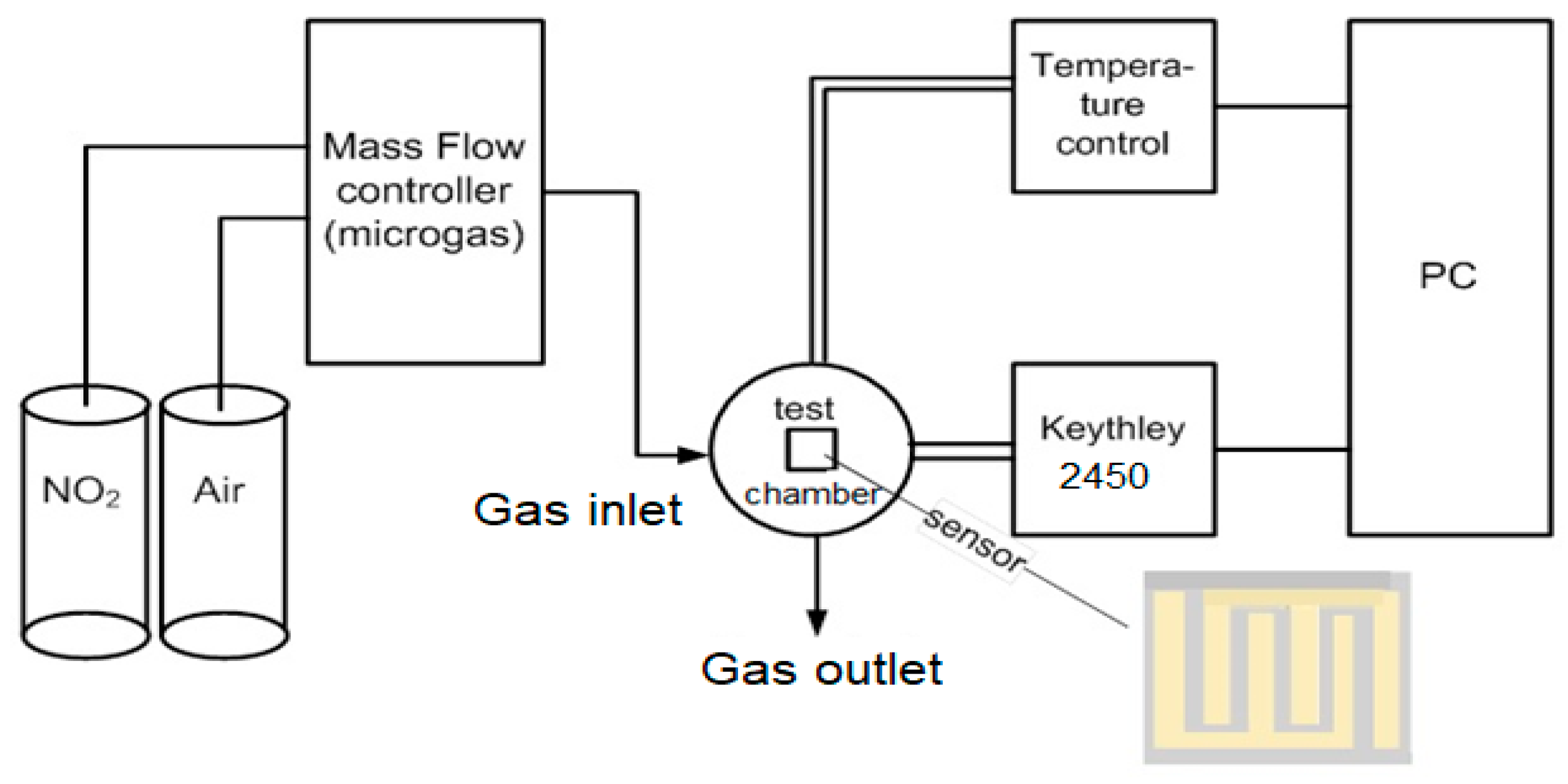
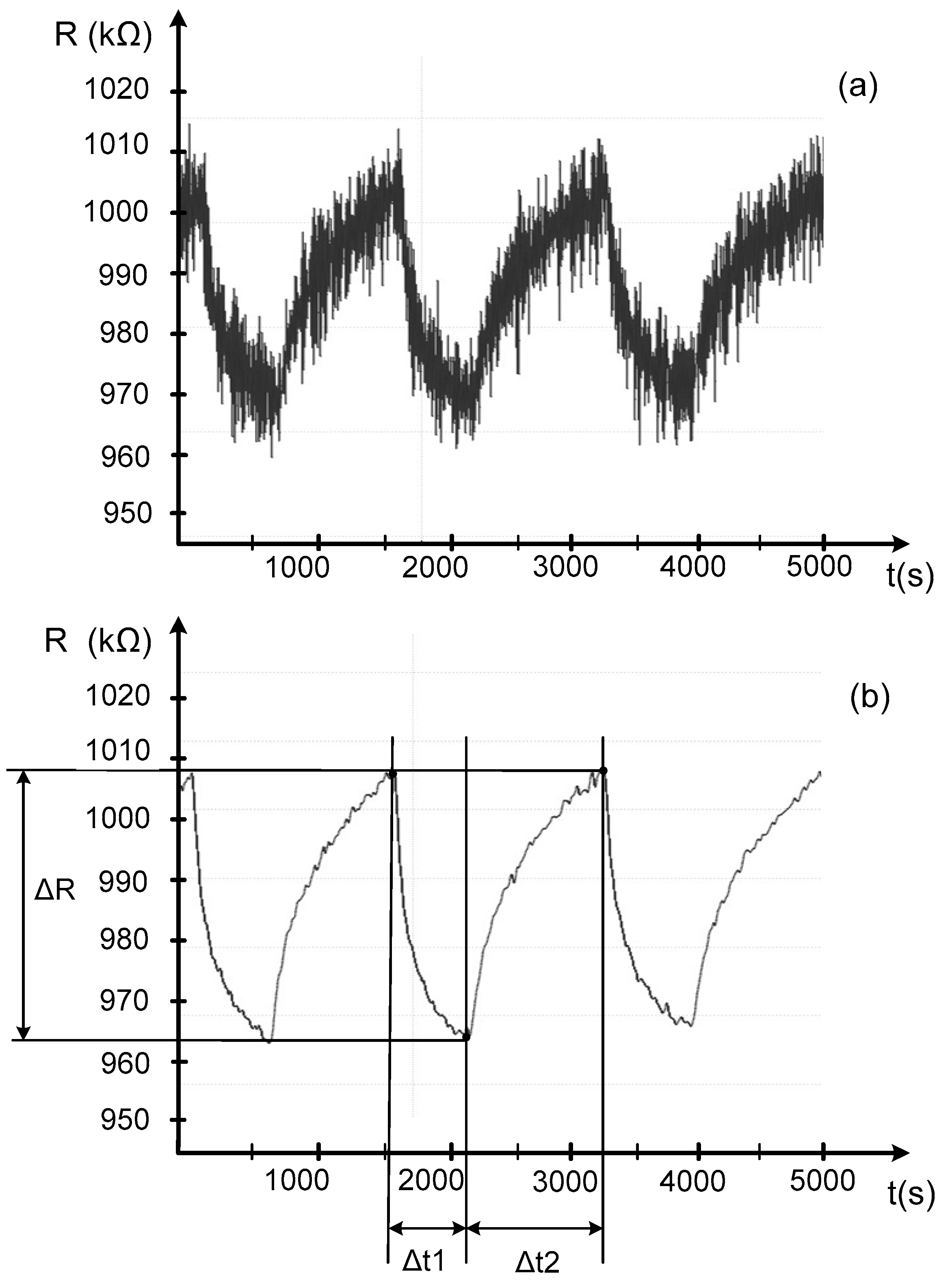
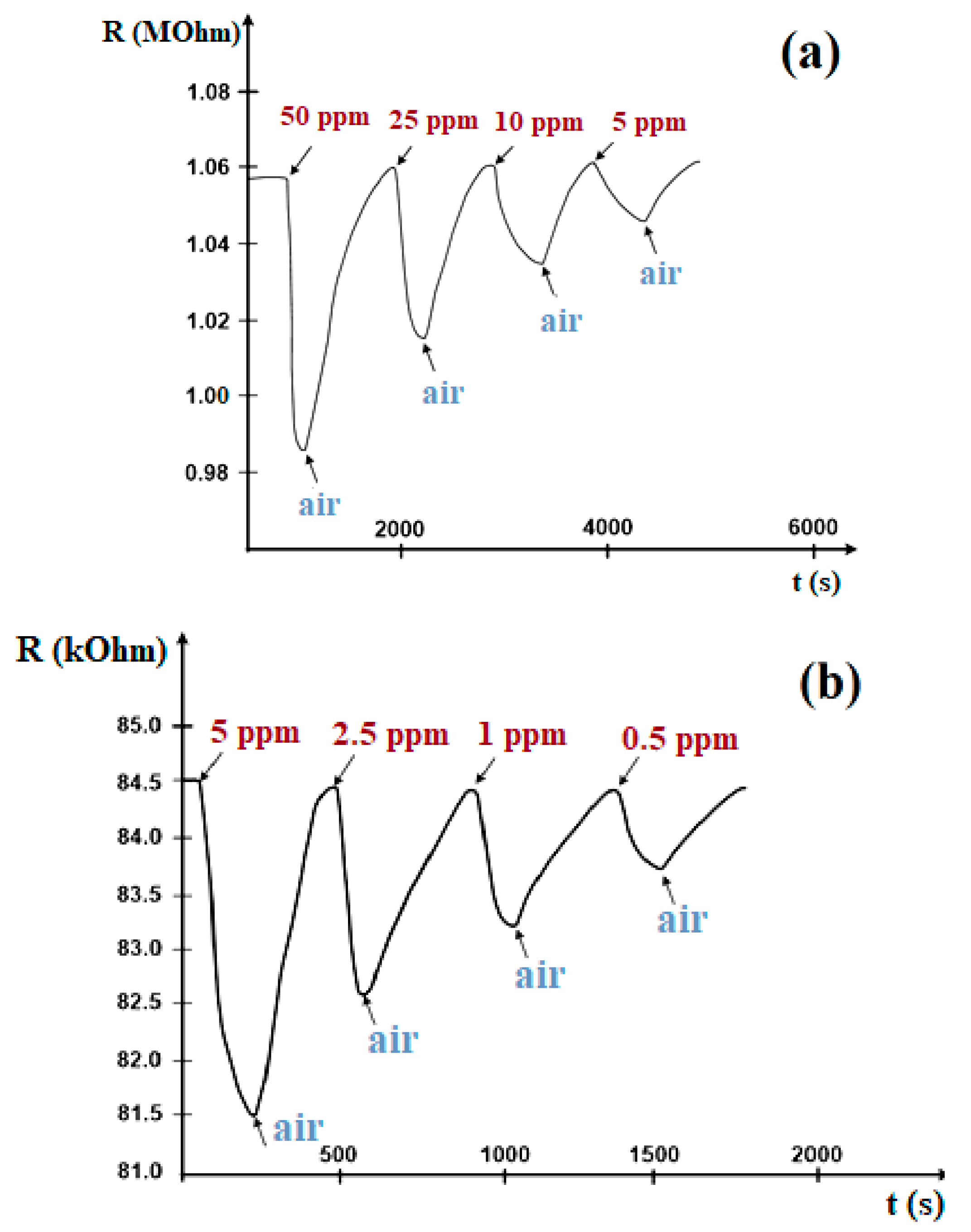
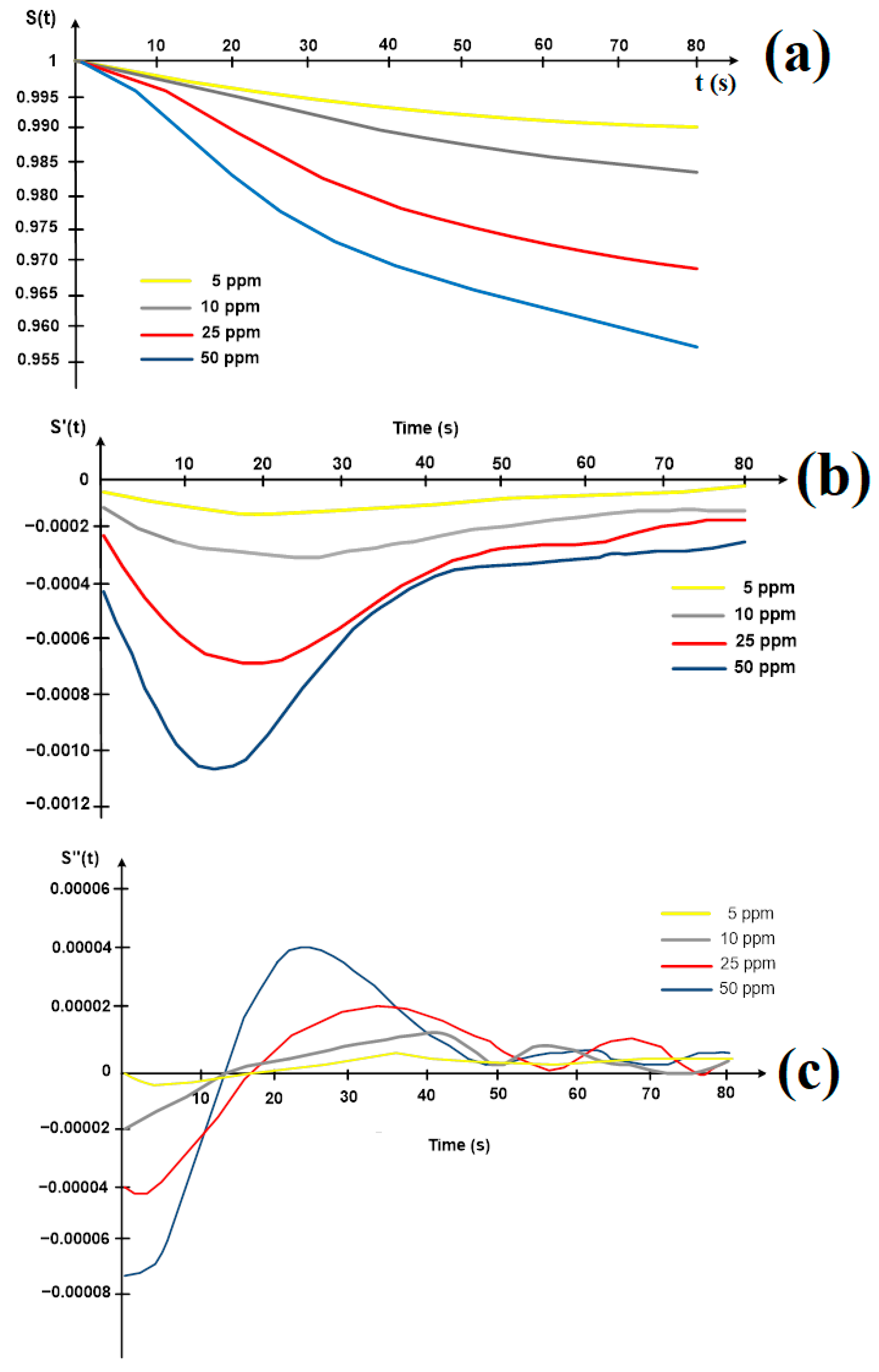
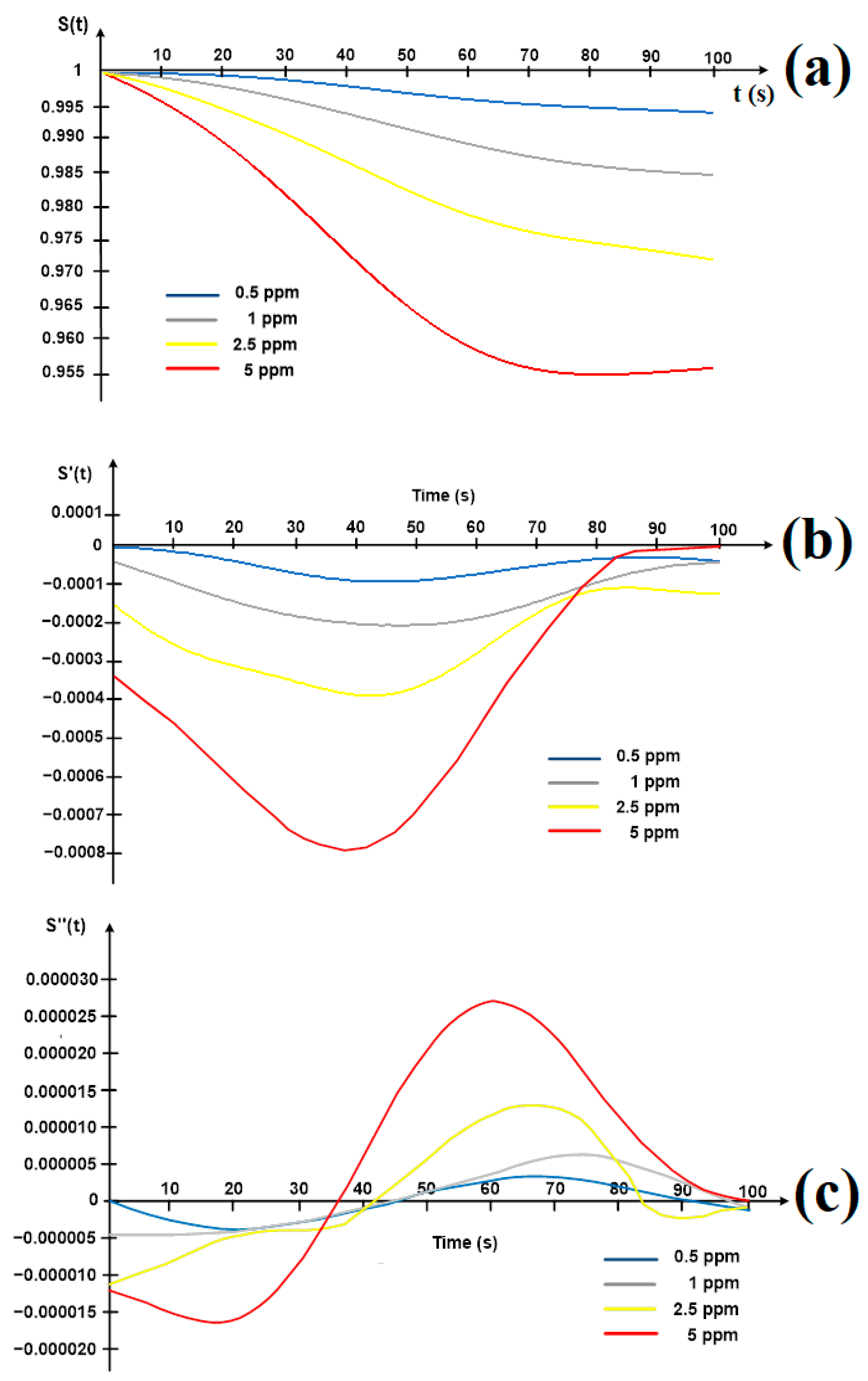
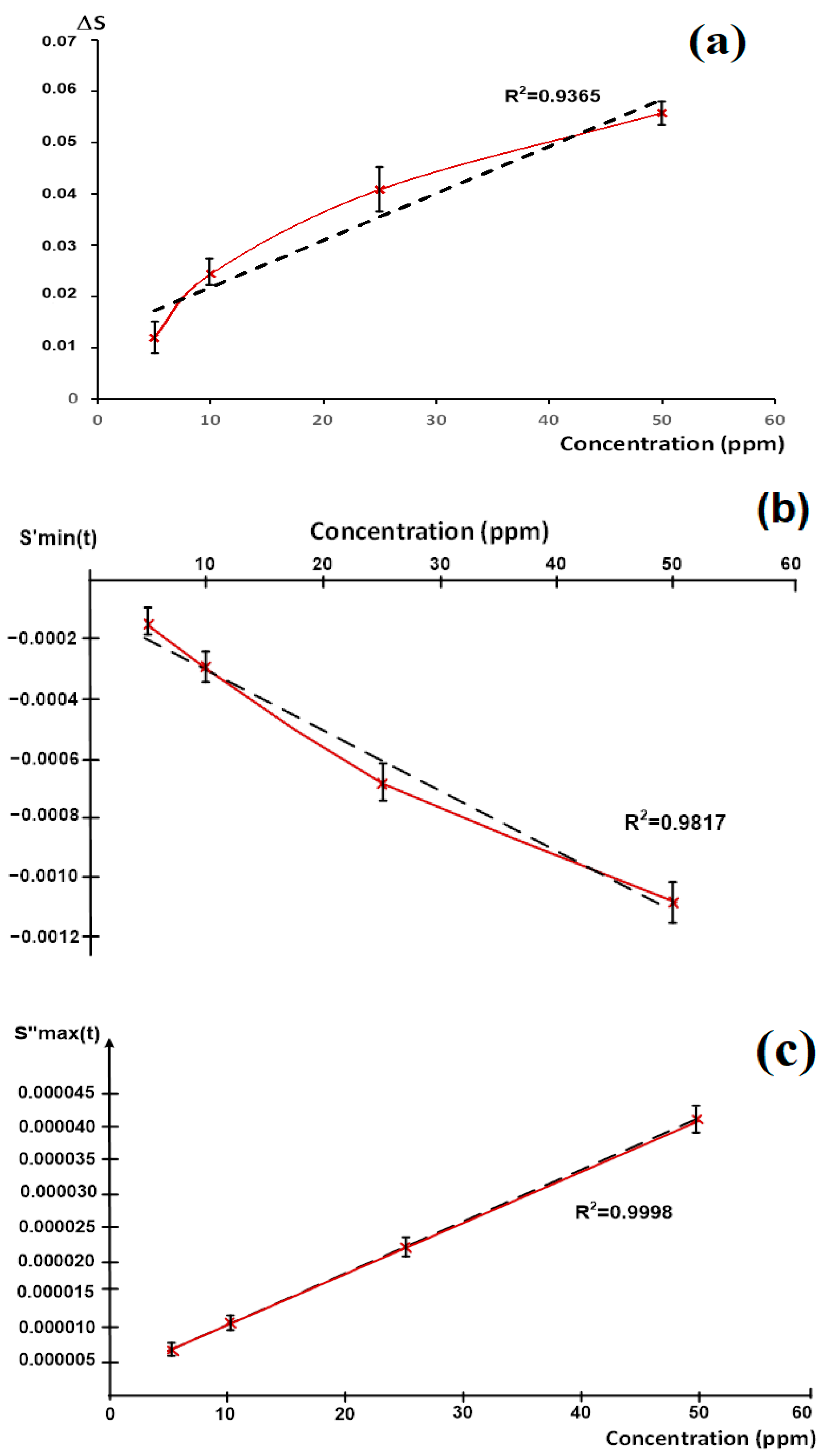


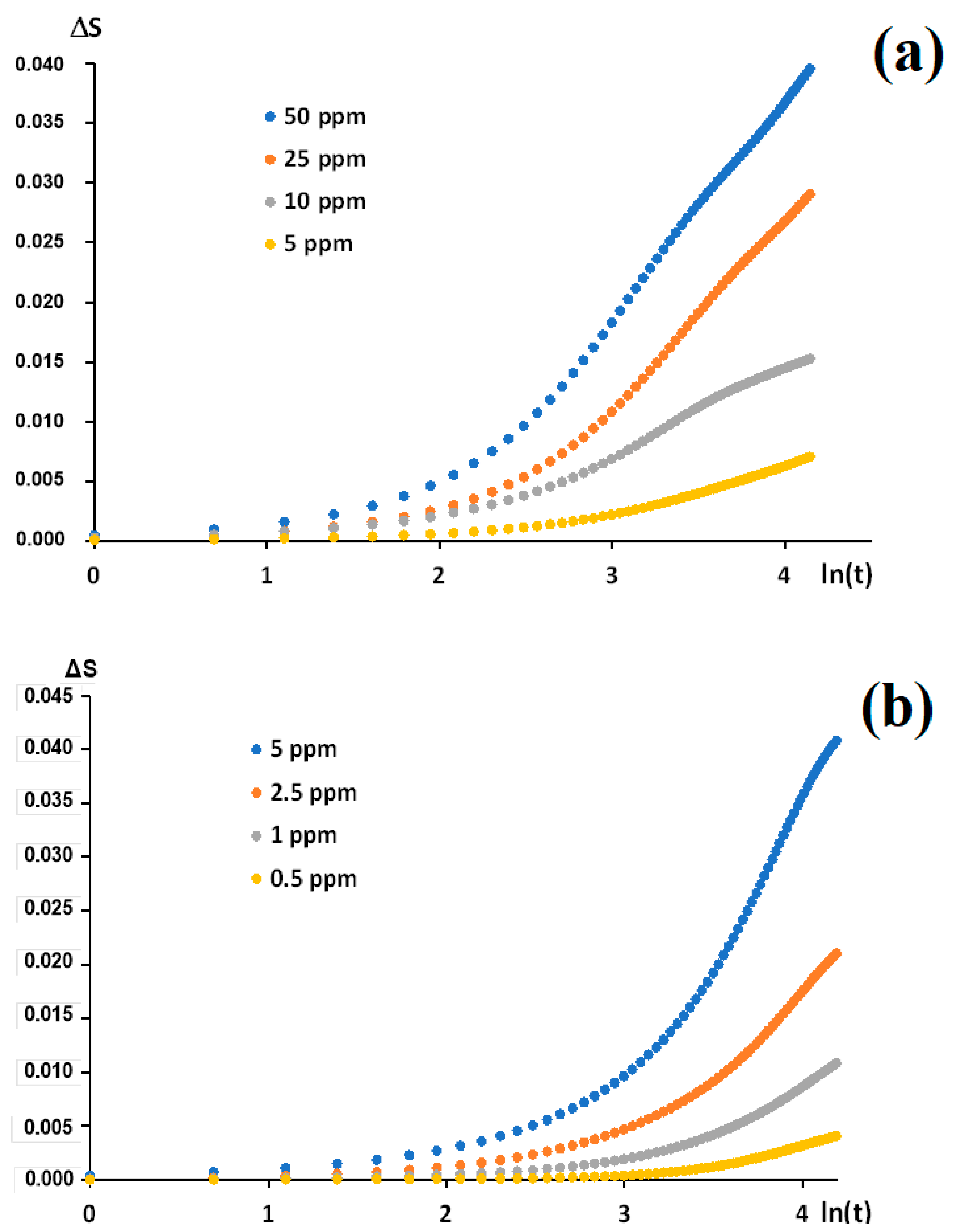

| Calibration Method | by ∆S | by a Minimum of S′(t) | by a Maximum of S″(t) | by S0′(t) | from Graphs ∆S vs. ln(t) |
|---|---|---|---|---|---|
| NO2 concentration, ppm | 36.1 | 34.8 | 33.3 | 32.5 | 33.5 |
| Relative error, % | 9.4 | 5.4 | 0.9 | 1.5 | 1.5 |
| NO2 concentration, ppm | 1.72 | 1.64 | 1.52 | 1.54 | 1.56 |
| Relative error, % | 14.6 | 9.3 | 1.3 | 2.6 | 4.0 |
Publisher’s Note: MDPI stays neutral with regard to jurisdictional claims in published maps and institutional affiliations. |
© 2022 by the authors. Licensee MDPI, Basel, Switzerland. This article is an open access article distributed under the terms and conditions of the Creative Commons Attribution (CC BY) license (https://creativecommons.org/licenses/by/4.0/).
Share and Cite
Plugotarenko, N.K.; Myasoedova, T.N.; Novikov, S.P.; Mikhailova, T.S. Comparative Analysis of Derivative Parameters of Chemoresistive Sensor Signals for Gas Concentration Estimation. Chemosensors 2022, 10, 126. https://doi.org/10.3390/chemosensors10040126
Plugotarenko NK, Myasoedova TN, Novikov SP, Mikhailova TS. Comparative Analysis of Derivative Parameters of Chemoresistive Sensor Signals for Gas Concentration Estimation. Chemosensors. 2022; 10(4):126. https://doi.org/10.3390/chemosensors10040126
Chicago/Turabian StylePlugotarenko, Nina K., Tatiana N. Myasoedova, Sergey P. Novikov, and Tatiana S. Mikhailova. 2022. "Comparative Analysis of Derivative Parameters of Chemoresistive Sensor Signals for Gas Concentration Estimation" Chemosensors 10, no. 4: 126. https://doi.org/10.3390/chemosensors10040126
APA StylePlugotarenko, N. K., Myasoedova, T. N., Novikov, S. P., & Mikhailova, T. S. (2022). Comparative Analysis of Derivative Parameters of Chemoresistive Sensor Signals for Gas Concentration Estimation. Chemosensors, 10(4), 126. https://doi.org/10.3390/chemosensors10040126








